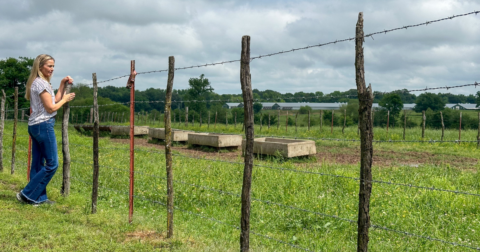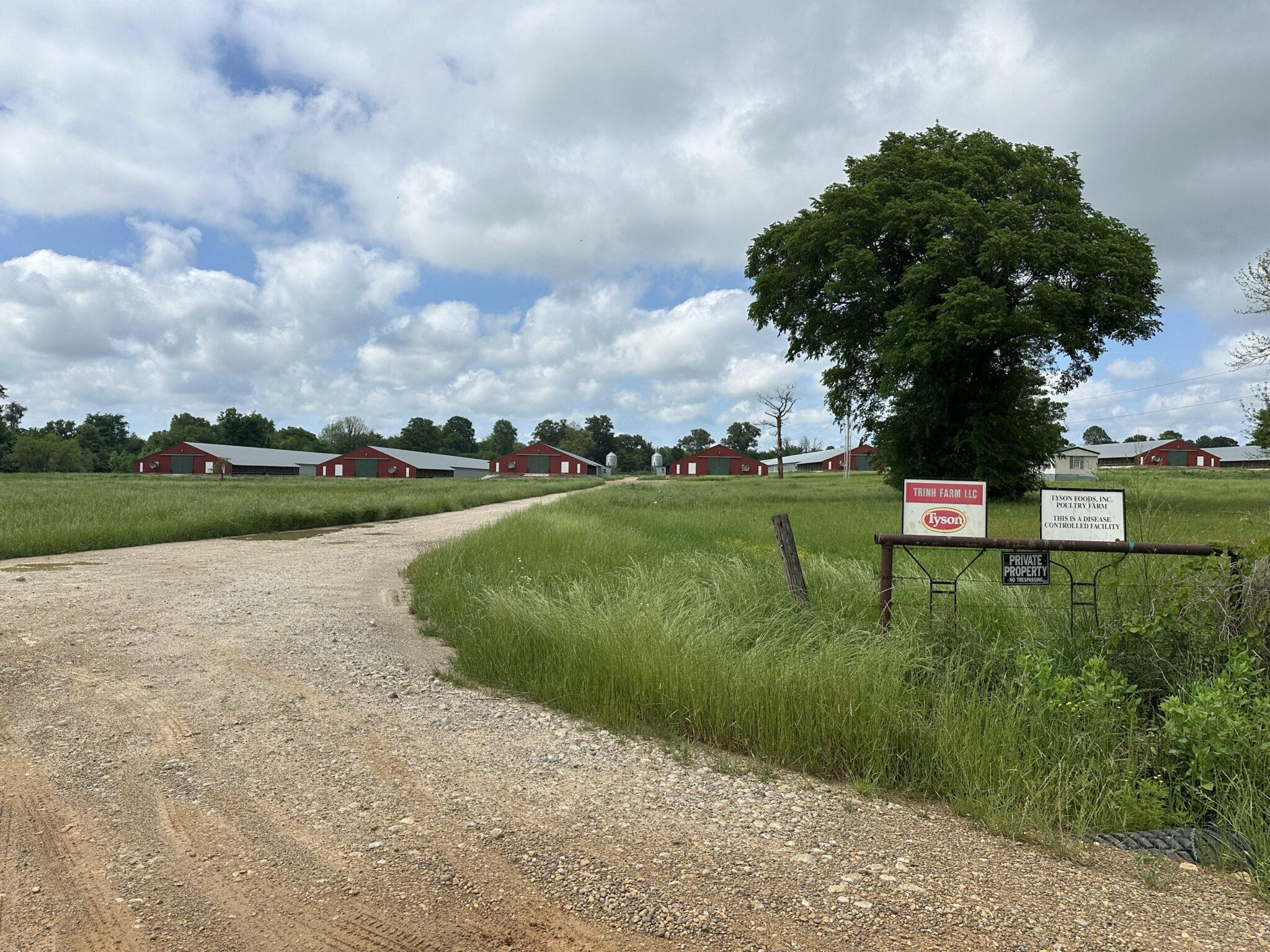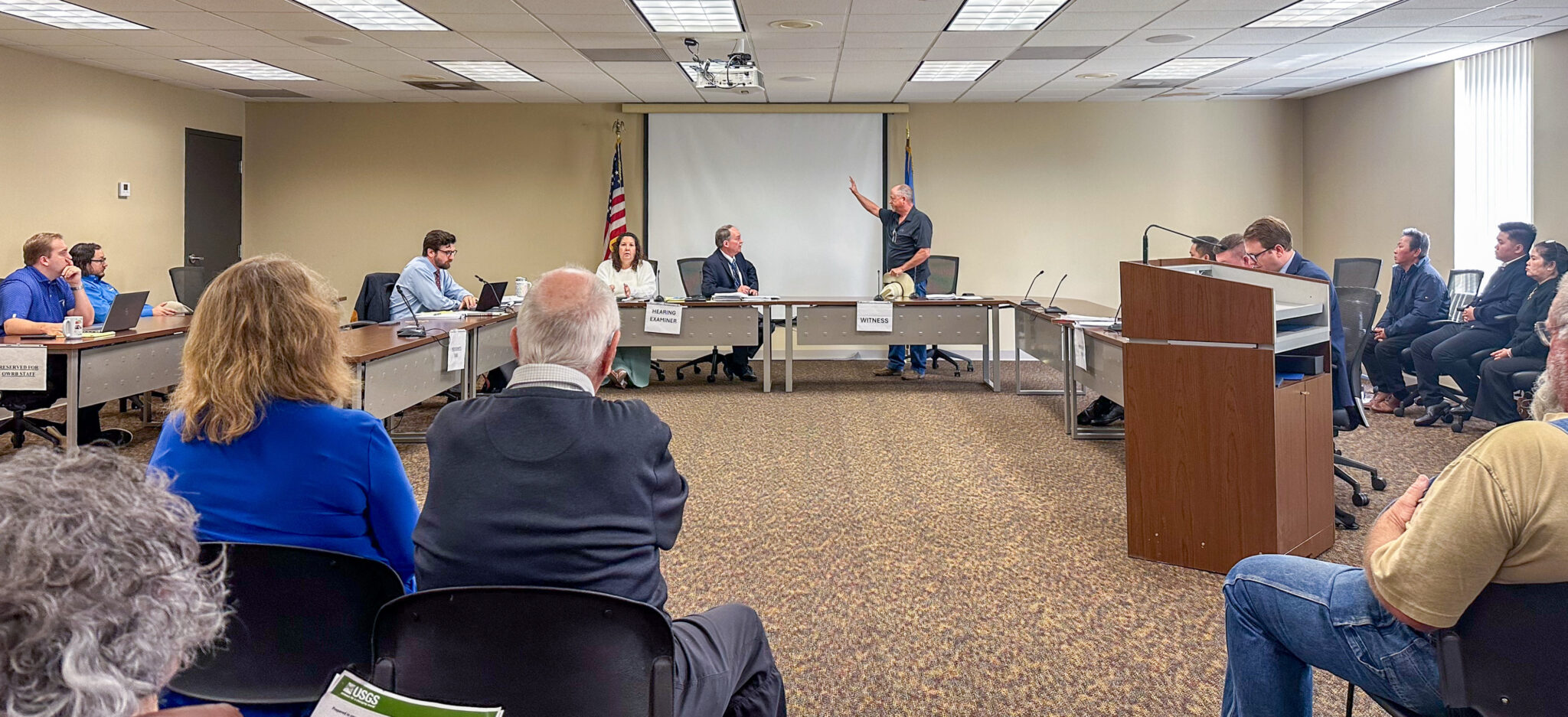Feature
How America’s Largest Meat Company Leverages Palantir’s Surveillance Tech
Food•10 min read
Investigation
While Tyson says its growers obtain water from ‘lawfully acquired sources,’ the state’s permitting system allows poultry operations to pump water without permits.


Words by Juan Vassallo, Investigate Midwest
This story was originally published on Investigate Midwest.
As Jill Trapp steered her pickup truck down the red dirt roads of southeast Oklahoma, she raised a hand to greet a passing neighbor — a calf roper who once made it to the National Finals Rodeo.
She drove on, passing a modest cowboy church where Sunday sermons share space with country music and the smell of brisket.
Then, rising among the cedar and elm trees, came a familiar and unwelcome sight: a row of long, gray, windowless chicken houses, each longer than two football fields.
“I try not to dwell on it. I pretend they’re not here,” Trapp said.
But soon her truck jolted as it rolled through a pothole — one of many left behind by the constant flow of semitrucks hauling hundreds of thousands of chickens through the area.
In this corner of the state, the poultry industry is hard to ignore.
Within a roughly 25-mile radius of the southeast Oklahoma town of Idabel, there are 59 industrial poultry farms — more than half built in the last 15 years, typically larger than older operations. Together, they raise nearly 7.4 million birds at maximum capacity. All but six grow chickens for Tyson Foods, the largest meat company in the country; the other six farms supply Pilgrim’s Pride, a Colorado-based, multinational food company.
Drone footage of a 20-house poultry operation behind Forest Grove Public School in Idabel, Oklahoma. video footage provided by Brad Phillips, McCurtain County resident. Beyond the usual concerns these farms raise — pollution and odors from the massive amounts of waste they generate, problems that have sparked lawsuits in Oklahoma and other states — residents in McCurtain County have another worry: the aquifer.
The region’s rapid growth — driven by poultry farms, marijuana farming, and a tourism boom in Hochatown — is putting mounting pressure on local water supplies. And locals are starting to wonder just how much strain the aquifer water can take.
Industry-friendly laws and nominal penalties have allowed companies like Tyson to operate with little accountability. Minimal oversight from state agencies often means residents have little information about whether the industrial poultry farms are polluting or depleting the region’s groundwater.
“I’m concerned that we’re going to overuse our waters and not have sustainability for the future,” said Charlette Hearne, a prominent water rights advocate based in Broken Bow.
When Trapp and her husband built their home about 20 years ago, they were drawn to the area’s remoteness and lush landscape — the perfect place, they thought, to start a family and raise cattle and backyard chickens.
But five years after settling in, a man knocked on their door.
He told them he had purchased the property next door and planned to build six large chicken houses. He also asked them not to raise any chickens, warning they could infect his flock and jeopardize his business.
“This initial disappointment didn’t compare to what happened in the last 15 years,” Trapp said last month at a community meeting in Idabel, attended by more than 150 people, including officials from the Oklahoma Water Resources Board.
She went on to describe the overpowering smells that fill her backyard whenever one of the farm’s chicken houses is cleaned out, the swarms of flies and layers of dust that settle on the walls of her house, and the noise from trucks hauling birds throughout the night.
“Each contract grower is required to comply with federal, state, and local laws, including the Oklahoma law to have a farm-specific Nutrient Management Plan (NMP),” a Tyson Foods spokesperson said in a statement. “The terms of each NMP include requirements for storage and disposition of poultry litter, as required under the Oklahoma Registered Poultry Feeding Operations Act. The NMPs are developed with measures designed to prevent discharge.”
The May 1 meeting primarily focused on a proposed 12-building chicken farm, which, if built, would become the second-largest poultry operation in the area.
The farm’s owners requested a permit from the Oklahoma Water Resources Board to use approximately 86 million gallons of water per year, equivalent to the average water usage of 785 four-person households.
Unlike most other chicken farms in Oklahoma, the cluster of farms in McCurtain County sits atop a regulated aquifer, the Antlers. These farms use water from the aquifer for bird consumption, sanitation and cooling the chicken houses.
The current limit for permitted water withdrawals from the Antlers aquifer is 2.1 acre-feet per acre, or more than 680,000 gallons of water for each acre of land — the highest allocation of any groundwater basin in the state. State officials set that limit in 1995 by dividing the aquifer’s estimated total volume by the acreage above it.

“Our law is designed to deplete the aquifer. It is designed to mine the water for economic purposes,” said Sara Gibson, general counsel for the Oklahoma Water Resources Board, during the meeting.
For Hearne, this admission makes one thing clear: Oklahoma’s water laws need to be updated to reflect the state’s growth and protect its natural resources.
She points to the Arbuckle-Simpson aquifer — adjacent to the Antlers — as a success story.
In the 1980s, local advocates pushed for federal recognition of the aquifer as the region’s only viable drinking water source — a designation that later helped residents push for a comprehensive hydrological study and block a plan to export water.
That study led to a significant change: the aquifer’s withdrawal limit dropped from 2.0 acre-feet to just 0.2 — the lowest in the state.
To Hearne, it’s a straightforward lesson of how science should guide water policy.
“You’ve got to know your monthly, daily, seasonal variations before you can issue permits properly,” she said.
But perhaps the biggest shock for those at the meeting came with the revelation that most poultry operations typically don’t apply for water permits at all.
Lobbying by the poultry industry in the 1990s led to a loophole where a permit isn’t required if a property owner claims the water is for “domestic use” rather than a business.
“If the farm is doing business as Bob and Mary Jo Smith, they don’t need a permit. If they’re doing business as Smith Poultry LLC, they do,” Gibson explained.
While the 63 industrial poultry farms in McCurtain County are owned by individual farmers, they raise chickens under contract with corporations like Tyson Foods and Pilgrim’s Pride, which tightly control their operations. Only four currently have water permits, with a fifth pending for the planned 12-house chicken facility.
Not only does “domestic use” allow a farm to operate without a water permit, but the operation can pull more than twice the amount of water from the aquifer compared to what is allowed under an agricultural use permit.
In practice, the situation is even murkier. Many farms registered as LLCs — which should have permits — also lack them, a gap that Gibson says she is working with Oklahoma Department of Agriculture, Food and Forestry (ODAFF) to address. The few farms that have applied for permits have likely done so to exceed the limits allowed under domestic use.
Meanwhile, water usage is essentially unlimited: the OWRB relies on an honor system for water reporting — the four poultry farms in McCurtain County with water permits reported zero use in 2024 —, and the agency has never revoked a permit or penalized anyone for exceeding their allowed water usage.
“The water used on farms is required to be obtained from lawfully acquired sources,” a Tyson Foods spokesperson said.
Last year, Gov. Kevin Stitt vetoed a bill that would have required metering devices on all groundwater wells across the state — a move praised by the agriculture industry and the Oklahoma Farm Bureau.
The Republican governor rejected the bill despite concerns over intensifying droughts and the agriculture industry’s heavy water use, particularly in northwest Oklahoma. The region recently experienced its second-driest period in over a century. And its main water source, the Ogallala Aquifer, has been significantly depleted by Seaboard Foods.
Even if there were stricter rules and required metering, there may not be enough money for enforcement or aquifer studies, according to Gibson.
The OWRB’s annual budget — excluding supplemental funds for water and wastewater infrastructure and other programs — has ranged from $5 million to over $8 million in recent years. The agency said it has fewer than 20 staff members to review an average of 250 permit applications and amendments each year, investigate issues and conduct fieldwork.
“We used to have field offices around the state. We don’t have those anymore,” Gibson said.

Many attendees at the meeting expressed concerns not only about water quantity but also water quality.
OWRB does not evaluate water quality before issuing a permit — it does not test for drinking water contaminants or assess the potential impact of runoff. And if an aquifer is suspected of being contaminated by a poultry farm, oversight falls to ODAFF.
Following the May 1 meeting in Idabel, Trapp decided to test her well water. The results came back positive for E. coli.
The lab notified her that the presence of the bacteria posed a “primary health concern,” though it could not determine the source of the contamination.
Asked whether proximity to a poultry farm could be the cause, Teena Gunter, general counsel at ODAFF, responded:
“[E. coli] is not common in well water near poultry farms,” she said. “Poultry farms are considered no-discharge facilities. So for anything to run off from that process would be a major violation.”
But Jayme Cannon, an environmental scientist with the Oklahoma Department of Environmental Quality, says well owners living near poultry farms should be concerned about bacteria like E. coli.
“If E. coli is consistently present in the well, yes, that is a cause for concern.” Cannon said. “E. coli is an acute health risk and if it is present in water, the water should not be used for drinking or consumption.”
Last year, an Oklahoma conservation group found elevated levels of E. coli and enterococcus in parts of eastern Oklahoma with a high concentration of poultry farms — an indication of animal feces contamination.
Trapp plans to retest her water to rule out contamination caused by recent storms. But even if the bacteria returns, proving it came from the Tyson farm next door would be difficult — and past violations by poultry farms have rarely led to serious penalties.
In 2023, ODAFF fined 14 poultry farms between $100 and $300 each for failing to submit or submitting late their litter management reports. The highest fine, $600, was issued to a farm that failed to renew its license or file any reports for three years. It was the only enforcement action taken by the agency.
“Agencies are limited in what they can do because of the authorities they’ve been granted by the legislature,” said Shanon Phillips, director of the water quality division at the Oklahoma Conservation Commission.

A bill passed last year increased the fines ODAFF can impose to $1,000 and gave the agency more authority to act when poultry farms break the rules.
But the same bill also granted poultry companies legal protection, shielding them from lawsuits as long as they comply with regulations.
That’s troubling, critics say, because even when farms follow the rules, pollution continues to be a problem.
In 2005, then-Attorney General Drew Edmondson sued a group of poultry companies over elevated phosphorus levels in the Illinois River watershed caused by chicken litter used as fertilizer. Rainfall and irrigation washed phosphorus from the litter into nearby streams and rivers, fueling algae blooms and degrading water quality.
After 18 years of litigation, a U.S. District Judge ruled in favor of Oklahoma, holding poultry companies — including Tyson Foods — responsible for polluting the watershed.
The companies pushed back, citing improvements since 2005. But at a hearing last year, six scientific experts testified that chicken litter pollution remains a serious problem. They presented data showing rising phosphorus levels, with some arguing that a ban on the use of chicken litter as fertilizer may be the only solution.
During this year’s state legislative session, Sen. George Burns, R-Pollard, introduced two bills aimed at stopping the growth of the poultry industry in his district after hearing from his constituents.
One bill proposed a moratorium on all new poultry farm applications, while the other would have required poultry farm owners to provide proof of residency.
“These people are from Vietnam. They are getting 1% loans. They come in here and put these mega operations all over southeast Oklahoma — and they are illegal,” Burns said during a February Agriculture Committee hearing. He later referred to the farms as “filthy operations.”
But the senator did not present any evidence that the poultry farms were operating illegally or that their owners were undocumented residents. Both bills ultimately failed in committee.
The bills, even if passed, would not have addressed the water concerns voiced by residents of McCurtain County.
Brad Phillips, who has lived on his land in McCurtain County since he was 10 years old, challenged the groundwater permit for the planned mega chicken farm next to his property. He and one of the applicants, Duc Minh Tran, appeared at a hearing at the Oklahoma Water Resources Board offices in Oklahoma City.
“We’re always about three weeks from a drought… it seems like in these more recent times my stock ponds go drier quicker,” Phillips said during his testimony.
Tran, who speaks limited English, gave brief responses during questioning. But after the hearing, his attorney, Bryan Nowlin, said Tran is an American citizen, is following the law, and wants to pursue the American dream by building a successful business.

Across the country, a growing share of poultry farmers are Asian immigrants, particularly Vietnamese and Laotian. Sen. Burns’ remarks reflect the suspicions of some McCurtain County residents, many of whom have either filed for bankruptcy as poultry farmers or know others who have. They question why a new wave of growers is willing to take on millions in debt to build farms for the same companies that drove others into financial ruin.
These tensions have been exacerbated by reports of undocumented workers and labor exploitation at marijuana farms, many operated by Asian immigrants.
Investigate Midwest could not independently verify whether immigrant farmers receive low-interest loans, special bonuses or subsidies. But many appear to operate under the same contract system that has long exploited chicken farmers.
Amanda Hitt, a lawyer who has spent more than a decade representing whistleblowers in the food system, urged the USDA to collect updated demographic data on poultry contract growers after working with clients who speak little or no English and have been subjected to exploitative, and often misleading contracts.
“They’re asked to just sign documents and they just go ahead. They don’t know what they’re signing. They don’t know why they’re signing. They just sign it,” Hitt said. “They’re very willing to take orders and directives and do more than their white counterparts.”
Jack Brown, who lives near the town of Valiant, has been a poultry farmer for Tyson since 1995. Last year, the company told him that his chicken houses were too old and they were ending his contract.
He said the early years were profitable. But then the company started penalizing him, withholding chickens for six months at a time for two consecutive years, without explanation. They kept demanding upgrades, which he made — spending $200,000 — until he could no longer afford to keep up.
“When I built my (chicken) house it cost $250,000,” Brown said. “Now it costs nearly $1 million. So I couldn’t keep up with the technology and production.”
With his main source of income gone, Brown, a retired electrician, has returned to work refurbishing turbines.
Brown knows some of the newer Asian poultry farmers in the area and maintains friendly relationships with them — as does Jill Trapp, despite her frustrations with the Tyson farm next door.
Trapp, whose neighboring poultry farm is owned by a Vietnamese man, describes a warm relationship with her neighbor. They exchange Christmas gifts, and she chats with his son when he visits, since he speaks fluent English. Her issue isn’t with the farmers themselves — it’s with the companies behind them.
“Corporations just have this individual to make it look like they’re a little chicken farmer, but they’re not,” Trapp said. “Big corporations, the big chicken houses and marijuana farms come in and they all dig wells… Now, that’s not a very untypical thing in agriculture. But they’re not individuals anymore.”
Investigate Midwest is an independent, nonprofit newsroom. Our mission is to serve the public interest by exposing dangerous and costly practices of influential agricultural corporations and institutions through in-depth and data-driven investigative journalism. Visit us online at www.investigatemidwest.org.
This article first appeared on Investigate Midwest and is republished here under a Creative Commons license.